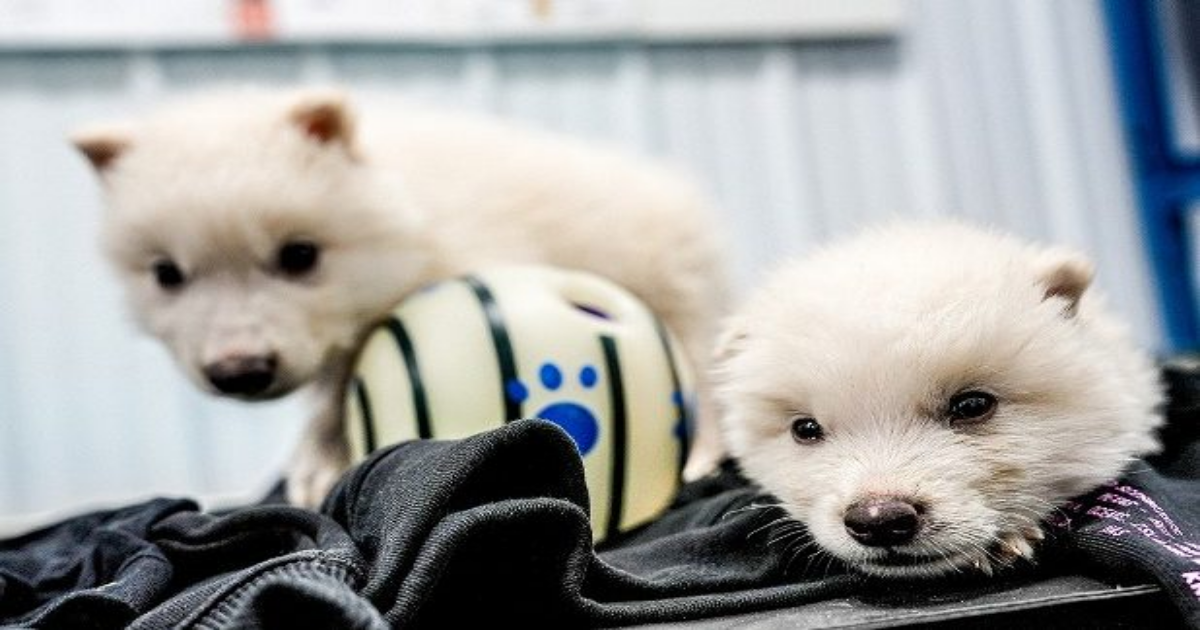Colossal Biosciences
Scientists have brought a breed of wolf back from extinction more than 12,000 years after it last walked the earth.
In what is believed to be the world’s first successful de-extinction, a US-based biotech firm has bred three dire wolves, a species popularised by the fantasy series Game of Thrones, by editing DNA recovered from ancient remains.
Colossal Biosciences Inc announced yesterday it had bred 80lb brothers Romulus and Remus – named after the fabled founders of Rome who were nurtured by a she-wolf – as well as a younger female pup called Khaleesi, which takes its name from the popular Game of Thrones character.
Footage of the wolves shows them whimpering as pups and frolicking in the snow at their fenced-in nature reserve at a secret US location.
Two of the one-month-old pups – Colossal Biosciences
Darya Tourzani, a reproductive biology scientist who worked on the project, described the breakthrough as “science fiction at its finest”.
Colossal describes de-extinction as the “process of generating an organism that both resembles and is genetically similar to an extinct species”.
A three-month-old pup – Colossal Biosciences
The researchers extracted DNA from a 72,000-year-old skull in Idaho and a 13,000-year old tooth in Ohio.
The team then ground up small samples of each body part, sequencing the DNA and analysing it for clues about the animal’s key traits.
“Getting the genome was really hard. They didn’t live in cold climates so the DNA wasn’t as well preserved,” Dr Beth Shapiro, the company’s chief science officer, told Bloomberg.
Dire wolves were popularised in the HBO series Game of Thrones
The scientists took cells from living grey wolves and made a record 20 gene edits to make the animals bigger, more muscular and give them the distinctive white coats of the dire wolf.
The cells were then inserted into egg cells from domestic dogs, and implanted into the wombs of another set of dogs, which served as surrogates. When the first dire wolf puppy was delivered via c-section, Colossal’s Matt James was immediately struck by its size.
Cells from living grey wolves were edited and then inserted into egg cells from domestic dogs – Colossal Biosciences
He said his first thought was: “Good Lord, this thing is huge,” as he picked up one of the brothers, and rubbed it between two towels to coax out the puppy’s first breath. “I can’t believe we’re holding the first dire wolf in 12,000 years,” he told Bloomberg.
The dire wolf pups have been raised on a diet of beef, deer, horse meat and a specially formulated dried pet food.
The wolves are around 20 to 25 per cent bigger than their closest living relative, the grey wolf, would be at their age and are expected to weigh 140lbs by the time they are fully grown, making them among the largest canines on the planet.
One of the wolves at five-months – Colossal Biosciences
The white-coated wolf once roamed the plains of North and South America during the Pleistocene epoch before going extinct about 12,000 years ago.
Dallas-based Colossal first made headlines in 2022 when it announced its goal to bring woolly mammoths back to life using gene-editing technology.
The $10.2 billion company has so far managed to create a wooly mouse.
The team of scientists have also bred two litters of red wolves – the world’s most endangered species of wolf – using a new approach to non-invasive blood cloning. The four puppies are named Hope, Blaze, Cinder and Ash.
In 2003, a team of Spanish scientists attempted to revive the extinct Pyrenean ibex, but it died soon after birth from a lung defect.





